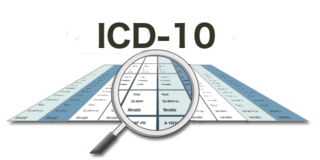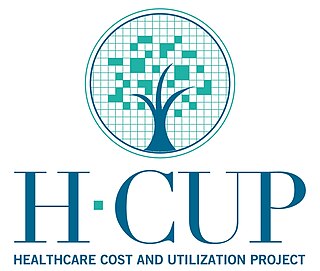The International Classification of Diseases (ICD) is a globally used medical classification used in epidemiology, health management and for clinical purposes. The ICD is maintained by the World Health Organization (WHO), which is the directing and coordinating authority for health within the United Nations System. The ICD is originally designed as a health care classification system, providing a system of diagnostic codes for classifying diseases, including nuanced classifications of a wide variety of signs, symptoms, abnormal findings, complaints, social circumstances, and external causes of injury or disease. This system is designed to map health conditions to corresponding generic categories together with specific variations, assigning for these a designated code, up to six characters long. Thus, major categories are designed to include a set of similar diseases.
The International Classification of Functioning, Disability and Health (ICF) is a classification of the health components of functioning and disability.
A medical classification is used to transform descriptions of medical diagnoses or procedures into standardized statistical code in a process known as clinical coding. Diagnosis classifications list diagnosis codes, which are used to track diseases and other health conditions, inclusive of chronic diseases such as diabetes mellitus and heart disease, and infectious diseases such as norovirus, the flu, and athlete's foot. Procedure classifications list procedure code, which are used to capture interventional data. These diagnosis and procedure codes are used by health care providers, government health programs, private health insurance companies, workers' compensation carriers, software developers, and others for a variety of applications in medicine, public health and medical informatics, including:
The Current Procedural Terminology (CPT) code set is a procedural code set developed by the American Medical Association (AMA). It is maintained by the CPT Editorial Panel. The CPT code set describes medical, surgical, and diagnostic services and is designed to communicate uniform information about medical services and procedures among physicians, coders, patients, accreditation organizations, and payers for administrative, financial, and analytical purposes. New editions are released each October, with CPT 2021 being in use since October 2021. It is available in both a standard edition and a professional edition.
The ICD-10 Procedure Coding System (ICD-10-PCS) is a US system of medical classification used for procedural coding. The Centers for Medicare and Medicaid Services, the agency responsible for maintaining the inpatient procedure code set in the U.S., contracted with 3M Health Information Systems in 1995 to design and then develop a procedure classification system to replace Volume 3 of ICD-9-CM. ICD-9-CM contains a procedure classification; ICD-10-CM does not. ICD-10-PCS is the result. ICD-10-PCS was initially released in 1998. It has been updated annually since that time. Despite being named after the WHO's International Classification of Diseases, it is a US-developed standard which is not used outside the United States.
Procedure codes are a sub-type of medical classification used to identify specific surgical, medical, or diagnostic interventions. The structure of the codes will depend on the classification; for example some use a numerical system, others alphanumeric.
In health care, diagnosis codes are used as a tool to group and identify diseases, disorders, symptoms, poisonings, adverse effects of drugs and chemicals, injuries and other reasons for patient encounters. Diagnostic coding is the translation of written descriptions of diseases, illnesses and injuries into codes from a particular classification. In medical classification, diagnosis codes are used as part of the clinical coding process alongside intervention codes. Both diagnosis and intervention codes are assigned by a health professional trained in medical classification such as a clinical coder or Health Information Manager.
The International Classification of Health Interventions (ICHI) is a system of classifying procedure codes being developed by the World Health Organization (WHO). It is currently available as a beta 3 release. The components for clinical documentation are stable. The component on public health interventions is in the process of being finalized. Updates on development and status of the classification are listed on WHO home page.

SNOMED CT or SNOMED Clinical Terms is a systematically organized computer-processable collection of medical terms providing codes, terms, synonyms and definitions used in clinical documentation and reporting. SNOMED CT is considered to be the most comprehensive, multilingual clinical healthcare terminology in the world. The primary purpose of SNOMED CT is to encode the meanings that are used in health information and to support the effective clinical recording of data with the aim of improving patient care. SNOMED CT provides the core general terminology for electronic health records. SNOMED CT comprehensive coverage includes: clinical findings, symptoms, diagnoses, procedures, body structures, organisms and other etiologies, substances, pharmaceuticals, devices and specimens.
Medcin, is a system of standardized medical terminology, a proprietary medical vocabulary and was developed by Medicomp Systems, Inc. MEDCIN is a point-of-care terminology, intended for use in Electronic Health Record (EHR) systems, and it includes over 280,000 clinical data elements encompassing symptoms, history, physical examination, tests, diagnoses and therapy. This clinical vocabulary contains over 38 years of research and development as well as the capability to cross map to leading codification systems such as SNOMED CT, CPT, ICD-9-CM/ICD-10-CM, DSM, LOINC, CDT, CVX, and the Clinical Care Classification (CCC) System for nursing and allied health.
Within the English National Health Service (NHS), a Healthcare Resource Group (HRG) is a grouping consisting of patient events that have been judged to consume a similar level of resource. For example, there are a number of different knee-related procedures that all require similar levels of resource; they may all be assigned to one HRG.
A clinical coder—also known as clinical coding officer, diagnostic coder, medical coder, or nosologist—is a health information professional whose main duties are to analyse clinical statements and assign standardized codes using a classification system. The health data produced are an integral part of health information management, and are used by local and national governments, private healthcare organizations and international agencies for various purposes, including medical and health services research, epidemiological studies, health resource allocation, case mix management, public health programming, medical billing, and public education.

ICD-10 is the 10th revision of the International Classification of Diseases (ICD), a medical classification list by the World Health Organization (WHO). It contains codes for diseases, signs and symptoms, abnormal findings, complaints, social circumstances, and external causes of injury or diseases. Work on ICD-10 began in 1983, became endorsed by the Forty-third World Health Assembly in 1990, and came into effect in member states on 1 January 1993. It was replaced by ICD-11 on January 1, 2022.
The National Clinical Coding Qualification (UK) (NCCQ) is a professional examination for clinical coders working in the United Kingdom.

The Healthcare Cost and Utilization Project is a family of healthcare databases and related software tools and products from the United States that is developed through a Federal-State-Industry partnership and sponsored by the Agency for Healthcare Research and Quality (AHRQ).

The ICD-11 is the eleventh revision of the International Classification of Diseases (ICD). It replaces the ICD-10 as the global standard for recording health information and causes of death. The ICD is developed and annually updated by the World Health Organization (WHO). Development of the ICD-11 started in 2007 and spanned over a decade of work, involving over 300 specialists from 55 countries divided into 30 work groups, with an additional 10,000 proposals from people all over the world. Following an alpha version in May 2011 and a beta draft in May 2012, a stable version of the ICD-11 was released on 18 June 2018, and officially endorsed by all WHO members during the 72nd World Health Assembly on 25 May 2019.
Read codes are a clinical terminology system that was in widespread use in General Practice in the United Kingdom until around 2018, when NHS England switched to using SNOMED CT. Read codes are still in use in Scotland and in England were permitted for use in NHS secondary care settings, such as dentistry and mental health care until 31 March 2020. Read codes support detailed clinical encoding of multiple patient phenomena including: occupation; social circumstances; ethnicity and religion; clinical signs, symptoms and observations; laboratory tests and results; diagnoses; diagnostic, therapeutic or surgical procedures performed; and a variety of administrative items. It therefore includes but goes significantly beyond the expressivity of a diagnosis coding system.
The Clinical Care Classification (CCC) System is a standardized, coded nursing terminology that identifies the discrete elements of nursing practice. The CCC provides a unique framework and coding structure. Used for documenting the plan of care; following the nursing process in all health care settings.
OPS, the Operationen- und Prozedurenschlüssel is the German modification of the International Classification of Procedures in Medicine (ICPM). For German hospitals it is currently the official coding system for medical procedures. Apart from its use for clinical controlling and performance statistics it is a basis for inpatient claims processing within the German Diagnosis-related Groups (G-DRG) system. Yearly OPS releases are produced by DIMDI. Besides OPS, G-DRG also requires disease codes based on ICD-10-GM is.
The ICD-10 Clinical Modification (ICD-10-CM) is a set of diagnosis codes used in the United States of America. It was developed by a component of the U.S. Department of Health and Human services, as an adaption of the ICD-10 with authorization from the World Health Organization. In 2015, ICD-10-CM replaced ICD-9-CM as the federally mandated classification. Annual updates are provided.



